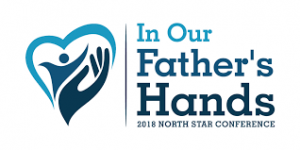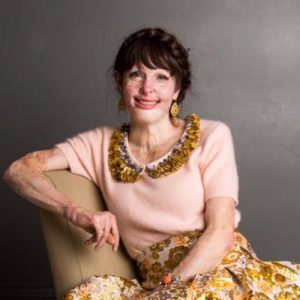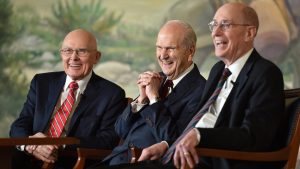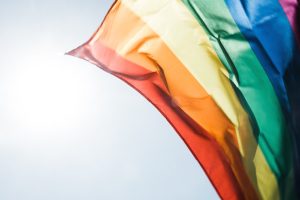North Star Conference; A Safe Haven For Members of The LGBTQ Community
The North Star organization is dedicated to offering support to those who are same-sex attracted but still desire to live the gospel faithfully. Its mission is to demonstrate that it is not impossible to be Mormon and gay. It is dedicated to providing resources to this unique, but growing, group of people and to offering community and support to them and their families.

North Star; Providing Hope For Those Who Otherwise Felt Hopeless
Those members of the LGBTQ community who also have desires to live in accordance with the gospel have otherwise felt isolated, as many of them grew to feel that they belonged to neither the gay community nor the Mormon one. This organization bridges the gap between these two groups, and as a result, has brought hope and happiness to many who felt otherwise at a loss for what to do.
The conference began with a beautiful musical number that set the tone for the entire day—”Nearer My God To Thee.” The atmosphere at the conference was one of acceptance and understanding. Overall, it was tailored to same-sex attracted individuals and their families. And even more specifically those who still seek to live in harmony with the covenants, beliefs, and values of the LDS church. I found that even though I am not gay, that I left the conference feeling uplifted and incredibly enlightened.
Stephanie Nielson
 The morning keynote speaker at the Saturday Conference was Stephanie Nielson, who is a woman very familiar with trials. In her speech, she discussed the hardships she went through after experiencing a plane crash and suffering severe burns over 80 percent of her body. Her body suffered irreparable damage and the healing process was slow and painful both physically and emotionally. Her message was incredibly fitting for the conference because it instilled hope.
The morning keynote speaker at the Saturday Conference was Stephanie Nielson, who is a woman very familiar with trials. In her speech, she discussed the hardships she went through after experiencing a plane crash and suffering severe burns over 80 percent of her body. Her body suffered irreparable damage and the healing process was slow and painful both physically and emotionally. Her message was incredibly fitting for the conference because it instilled hope.
Stephanie quoted a song that a dear friend wrote for her after her accident, “Like a butterfly in a cacoon, it takes time to heal all wounds.” We may come out scared, but more importantly—transformed. Stephanie explained that she knows, from her experience, that God has a plan for each of us as individuals. She is a testament that we can make it through whatever it is we face in life, including traversing the uncharted territory of being a gay Mormon.

We Are A Diverse People, And That’s Great!
We only have one life to live, and Stephanie asserts that living it without belief is wasting it. Stephanie closed her keynote address with the dying words of Joan of Arc; who is a woman whose story inspires her. “We are all spiritual beings having a human experience, and that experience has great variation.” At its core, her address centered on the fact that we are diverse beings having diverse experiences.
We should celebrate this diversity and it should in no way be something we are ashamed of. Each individual’s experience gives them a unique perspective and will only prove to enable them to help others, just as Stephanie’s experience has allowed her to help so many.
 If you are as interested as I am to learn more about her tenacity and experiences, you can buy her book “Heaven is Here; An Incredible of Hope, Triumph, and Everyday Joy.”
If you are as interested as I am to learn more about her tenacity and experiences, you can buy her book “Heaven is Here; An Incredible of Hope, Triumph, and Everyday Joy.”
First Breakout Session
After the keynote address, there were a variety of breakout sessions to choose from. Each one was run by an expert on the topic being discussed. Some were tailored specifically for church leadership. Others were for the parents and loved ones, and many more focused on navigating the difficult situations that accompany being a gay Mormon.
Understanding and Navigating Mormon Faith Crisis
This was the first breakout session that I attended and it was incredibly insightful. It was run by Jana Spengler who is an Integral Associate Coach who works for Symmetry Solutions. Jana is trained in developmental psychology and specializes in aiding people as they go through faith crises. She also helps couples that belong to different faiths find common ground. She is LDS, and so is a particularly reliable authority to look to on the subject of faith crisis in the Church.
There is a common saying that, “Christianity comforts the afflicted and afflicts the comfortable.” This saying was incredibly apparent during this presentation.
Faith crises can be big and small and are especially rampant among the SSA (same-sex-attracted) members of the Church as they struggle to find their place in the gospel and in life. Faith crisis, though, can really apply to any member of the Church. I realized as she spoke that there have been times in my life where I may not have left the Church physically but that I checked out spiritually. My faith wavered because of questions and lack of motivation to participate and do the things I was supposed to do.
Unlocking the Mormon Brain
Jana explained that, generally, the Mormon brain tends to think higher is better. As a Church, we believe that we must always be striving to improve. As a Church, we are dedicated to growth. This is, of course, very true, but it is often what draws people into a faith crisis, or in other words, loss of testimony. This is because after some individuals “arrive” at their faith, they are often unsure of what to do next to improve.
Instead, many pray, read, and go to church on auto-pilot and don’t really progress. I have fallen prey to this, and, I think, so has everyone else.
In Western philosophy, we are unfamiliar with being in touch with things that are not tangible like feelings and emotions. But as we know, faith is essentially entirely based on trusting and acting on things that we do not see. In fact, there are many that discount faith for this reason alone; that it cannot be based on concrete evidence or facts.
In the East, they do better with this. There are dual and non-dual ways of thinking. The dual are those concrete things like truth, words, and rational thinking. The nondual are those things like God, paradox, love, trust, and spiritual experiences. It is interesting that love and relationships are so valued in our society, yet the Western brain tends not to trust them because they belong to the nondual group.
The Stages
In order to better understand the causes of faith crises, she mapped out the different stages of spiritual development, and where, within those stages, faith crisis can often occur. It is important to note that development doesn’t always mean growth upwards or in a good direction. The stages she mapped out for us were modeled after James Fowler’s Stages of Faith.
 Stage 1: The Intuitive Projective Stage
Stage 1: The Intuitive Projective Stage
This stage usually takes place during early childhood (especially if the person is born within the covenant). This is the stage where images and stories lay the foundation for the person’s beliefs and eventually their testimony.our most basic ideas about God are picked up from our parents at this stage.
Stage 2: The Mythic / Literal Faith Stage
This stage is comprised mostly of stories limited to concrete thinking. Essentially, it is the black and white thinking we are taught as children, that good is God and evil is the adversary. Generally, stories like Noah and the Whale, and Moses and the burning bush are related using storybooks and cartoons at this stage. Nearly all people, especially in the West, are at least past stages one and two. Therefore, stages 3 and 4 are where most people reside.
Stage 3: The Synthetic / Conventional Faith Stage
 This is the stage where the majority of humans reside and is where the bulk of religions reside, Jana explained. This is where the individual is committed to church and leaders whole-heartedly. There is little to no doubt at this stage, but that is mostly because someone at this stage doesn’t question any aspect of their testimony or the Church. Stage three is where it all makes sense.
This is the stage where the majority of humans reside and is where the bulk of religions reside, Jana explained. This is where the individual is committed to church and leaders whole-heartedly. There is little to no doubt at this stage, but that is mostly because someone at this stage doesn’t question any aspect of their testimony or the Church. Stage three is where it all makes sense.
Stage 4: The Individual / Reflective Faith Stage
This stage is where there is a lot of discomfort. This is where the individual really begins to examine their faith closely. This is generally where people begin to ask questions. This does not necessarily mean that the individual questions their entire testimony, but means that they seek greater understanding and answers to some of the more difficult questions.
This stage often happens in early adulthood, as “people start to look outside the box and see that there are other boxes.”As we discussed earlier, Western thinking is very black and white, but when we come to learn that a lot about the world is not just black and white, we begin to question what we thought to be true. Although this stage does not necessarily indicate faith crisis, if a crisis does occur, it is generally at this stage. This is where individuals may begin to question the authority of church leaders.
This type of questioning does not always lead to backsliding as it may appear. In fact, it can lead to heightened testimony and if one presses on and doubts their doubts before they doubt their faith.
Stage 5: The Conjunctive Faith Stage
This is a point in life that most people do not reach until at least the middle of their lives. Essentially, this stage is where a person has reached a point where they realize that logic alone is limited. For this reason, they begin to accept and pursue more mystical things. The word mystical carries negative connotations in our church, but here it simply means those intangible things that are invaluable to a strong testimony.
People in this stage begin to value the lessons learned from the previous stages. Here, you become so dedicated to your faith that you sacrifice much of your life for it.
Stage 6: The Universalizing Faith Stage
 Very few people reach this stage. This stage is mostly comprised of people like Mother Theresa and the apostles and prophets. People in this stage dedicate their entire lives to their faith without any worry or doubt.
Very few people reach this stage. This stage is mostly comprised of people like Mother Theresa and the apostles and prophets. People in this stage dedicate their entire lives to their faith without any worry or doubt.
An Overview
The long and the short of this entire breakout session was that there is no wrong way to have faith, and there isn’t just one way to be Mormon. No one’s faith journey looks the same. Faith is a heart experience, not an intellectual exercise. We do not usually choose faith crisis, it is just something that happens. Often times, when people enter stage 4 and begin to question, it is not for lack of doing the things they are supposed to.
In fact, for many, stage 4 comes during a time in their lives when they are praying and reading more frequently than they ever have. It is possible to be “both/and” when it comes to faith. It is possible to both have questions and remain strong in your faith. Humans do not like the uncomfortable territory that is cognitive dissonance. Holding two conflicting thoughts in mind at once is largely just a part of life that needs to be
Jana gave us some tips on how to deal with faith crisis in our own lives and in the lives of others. One of the main things she stressed was that we should not proselyte to people who are not interested. Another important thing to do is to honor everyone’s faith journey and trust people to do it their own way. Counsel should be given carefully and only when inspired by the Spirit.
When We Question
If we enter into stage 4 territory, we should remember that it is ok to have questions. Joseph Smith and Nephi were constantly asking questions. It is important that we know these things for ourselves. We must simply be sure of the source when what we hear is contrary to what the establishment.
It is possible to learn to fall in love with questions more than answers. We have so many more unanswered questions in the Church than we do answers and that is ok. The answers will come when we need them, but sometimes the Lord lets us live in ambiguity because this is where faith develops and grows.
 Second Breakout Session
Second Breakout Session
Brother Tom Christoffersen and a number of other gay Mormons making up a panel ran the second breakout session I attended. This session centered around how single gay people in the Church can create a space for themselves. This session was run like a Q&A and was tailored to those striving to live as single, worthy members of the Church.
Living Joyfully As A Gay Mormon
One of the main things mentioned was that it is ok and even encouraged to be open about your SSA with your ward, and especially your leaders. The best way to avoid being uncomfortable or making others feel uncomfortable is to be out and open in your ward. Be open and happy and find an appropriate way to share it with your ward when you are ready.
especially your leaders. The best way to avoid being uncomfortable or making others feel uncomfortable is to be out and open in your ward. Be open and happy and find an appropriate way to share it with your ward when you are ready.
When Living Faithfully Seems Impossible, Remeber…
All gay Mormons have a unique experience and perspective. It is important to be involved in temple work as often as possible, as this is a way for gay singles to “multiply and replenish” the earth since they are not able to in the traditional sense.
It is a waste of time to dwell on what you can’t or don’t have. Instead, strive to recommit yourself every day to loving God even more than you love your identity. Don’t look at your SSA as a burden but as a gift. When we are focused inward, it becomes more difficult to cope with our circumstances. Focusing outward will give hope and an eternal perspective for those unsure that they can live faithfully. Through the Savior, your experiences can be sanctified.
There is a special place for everyone in the Church. In order for a gay member of the Church to live worthily, they have to make sacrifices that many others would not be prepared to make if we were in their shoes. We should applaud them for their faith and commitment to live the gospel.
Third Breakout Session
I was torn between where to go during this session because there were so many good options to choose from. I eventually settled on one that focused on reading the scriptures in a productive way.
Overcoming The Natural Man When Applying The Scriptures
When we read the scriptures, our natural man can often get in the way. Sometimes, when we don’t have the right mindset, we can read something and feel shame or oppression rather than feeling uplifted. The scriptures are to be used to bring us closer to the Lord and are tools to this end.
The reason we have scriptures in the first place is not to make us feel small. Their purpose is to inspire us to be better, humble us when necessary, and to give peace and hope in hard times. They are not there to make us feel ‘less than.’ They are simply there to remind us of God’s laws. When we fall short, we should not despair, but rather, should glory in the Atonement.
Do not let your natural man convince you that the Atonement, which is an infinite resource, is actually a finite and depletable one. This is a falsehood. We do not get an allotted amount of redemption and that is it for us. Just as it says in Mosiah 26:30 “As often as my people repent will I forgive them.”
Closing Keynote
Bennet Borden, the president of North Star, gave the closing keynote speech. Bennet and his wife both experience SSA and have made it their mission to show to others that it is possible to be both gay and Mormon. He explained that the world tells us that being gay and being Mormon are incongruent truths. But he claims that this only appears to be the case because there is a piece missing.
We are missing something that will bridge the gap between the truths and make them cohesive. We are all made the way we are for a specific purpose. Bennet went on to say that those who experience SSA are meant to be agents unto the Lord. We are born into a specific time, place, and family in order to bring about our best development.
You are Unique!
There is a purpose to it all. Bennet encouraged all in attendance to seek to know just what that purpose is. We have all been blessed with powerfully unique qualities. We can all be instruments in the Lord’s hands because we are all specially crafted.
The LGBTQ and SSA communities have unique perspectives to bring to the Church. There is great power in living at the edges of the bell curve. He encouraged everyone to make a firm commitment to the Lord to do the best they could. He also counseled that when we find we aren’t doing as well as we should that we must check ourselves and readjust.
Our sexual attractions are not the only things that define us, he says. It is only a piece. The world will tell you that the only legitimate choice for an SSA individual is to act according to their desires and to choose a partner. But we have the freedom to use our agency to go against this. Living in a society where we (SSA individuals) are “other” makes us unique and gives us the opportunity to be a beacon.
David Archuleta
 The conference went out with a bang! David Archuleta performed and addressed the audience as well. His words were genuine and inspiring and went right along with the spirit of the conference. He performed some covers from the new hit movie “The Greatest Showman,” as well as a cover of the song “True Colors,” which was very fitting for the conference. I will admit that his music is not usually my taste, but his performance contributed to the conferences’ atmosphere of acceptance and love for one another. I cant think of a better way to have ended such a “Glorious” conference.
The conference went out with a bang! David Archuleta performed and addressed the audience as well. His words were genuine and inspiring and went right along with the spirit of the conference. He performed some covers from the new hit movie “The Greatest Showman,” as well as a cover of the song “True Colors,” which was very fitting for the conference. I will admit that his music is not usually my taste, but his performance contributed to the conferences’ atmosphere of acceptance and love for one another. I cant think of a better way to have ended such a “Glorious” conference.
If you were able to attend the conference, I would encourage you to share your experience in the comments below. If you were unable to make it this year, don’t worry, there is always next year. I would encourage everyone, same-sex attracted or not to attend and feel of the amazing spirit there.


